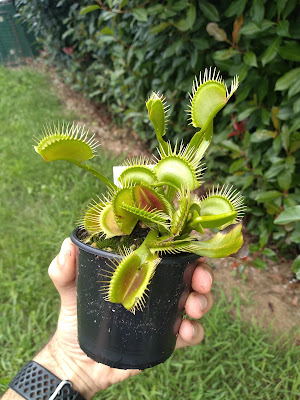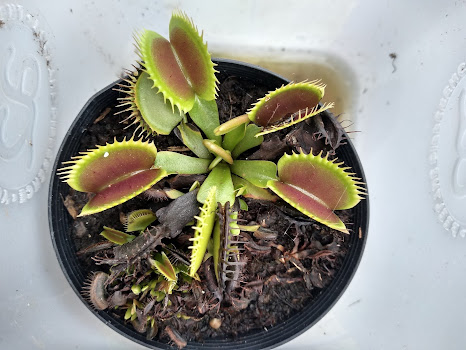Venus flytrap is a single species (Dionaea muscipula) that can not hybridise with anything else other than venus flytraps. All of the venus flytraps we grow are pure Dionaea muscipula. That being said, there are numerous venus flytrap cultivars.
Most (if not all) venus flytrap varieties will not grow true to type even if self pollinated. Every seed you grow will end up as a unique plant.
Some Venus flytrap varieties have upright growth over summer, some have low growth all the time, some are completely green, others are red, others have coral coloured traps, some are tiny plants, others grow impressively large, some have weird traps, some divide like mad, etc. This diversity has come about mostly by conventional breeding and a few have arisen from mishaps in tissue culture.
There are no blue venus flytraps, and there are no black venus flytraps.
Growing venus flytraps from seed is not for beginners, you are far better off getting a mature plant rather than growing out a seed for 4 or so years.
I grow a few varieties of venus flytraps. I have written a few blog posts on individual varieties:
Venus Flytrap 'Big Vigorous'
While describing a variety is good, I thought it would also be useful to do a side by side comparison of different varieties. This is only in my garden in my conditions, and may be different if you did these comparisons in different climates. While some Venus Fly Trap varieties may thrive in my climate, they may struggle elsewhere.
I have used 'Wally' Venus Flytrap as the standard to compare everything against. Wally is such a great clone and I have good numbers of them so they made an obvious choice for me to use as the standard to compare everything against.
Wally vs Low Giant Venus Flytraps
Wally Venus Flytrap and Low Giant Venus Flytrap are both low growing clones that tend to clump. Both are hardy, simple to grow, and not too finicky about growing conditions.
These two were both similar sized divisions taken from large healthy plants. They were potted in the same media, on the same day, in the same size/type of pot, and grown in the same tray of water side by side.
Wally on the left has clumped and produced more divisions than Low Giant on the right. The traps of Wally are larger, it has produced far more leaves, and the plant has more colour overall. The colour of Wally vft tends to be red/purple and starts in the trap interior but can be over the entire plant.
Low Giant has produced smaller traps, fewer traps, has less colour overall, is a noticeably less vigorous plant, and is more of a red colour in the trap interior.
 |
| Venus Flytrap comparison: Wally VFT on left vs Low Giant VFT on right |
Wally vs Big Vigorous Venus Flytraps
Wally Venus Flytrap is a low growing clumper, Big Vigorous Venus Flytrap has upright summer growth and tends to divide less frequently.
These two plants were both similar sized divisions (both larger than the ones above) taken from mature and healthy plants. They were potted in the same media, on the same day, in the same size/type of pot, and grown in the same tray of water side by side.
Wally has low summer growth with large traps that are significantly smaller than the traps of Big Vigorous. The trap colour of Wally is much redder. Wally has divided into many new plants meaning that there are plenty of open traps in the clump.
Big Vigorous Venus Flytrap has very tall upright growth with very large traps. The trap colour of Big Vigorous is more of a coral colour. Big Vigorous has only divided into a few plants but still has a decent number of open traps making it an impressive looking plant.
 |
| Venus Flytrap comparison: Wally VFT on left, Big Vigorous VFT on right |
 |
| Venus Flytrap comparison: Wally VFT on left, Big Vigorous VFT on right |
 |
| 'Wally' Venus Flytrap |
 |
| 'Big Vigorous' Venus Flytrap |
Wally vs Upright Red Traps (possibly schuppenstiel) Venus Flytraps
I got some unnamed venus flytraps, one of them impressed me and I kept it and because I can't be certain of the variety I call it 'upright red traps'. Mature plants develop leaf scaling during summer and I think it may be Schuppensteil, but I am not certain. Wally is a low growing clumper, while Upright Red Traps has upright summer growth.
The plants below were similar sized division, planted in the same size/type of pot of the same media on the same day. They were grown side by side in the same tray of water. I only planted one division of Wally on the left, and multiple divisions of Upright Red Traps on the right.
Wally had more colour, both in the traps as well as on the leaf petioles. Wally produced more leaves and more traps on the plant. You can't see in this photo but Wally also produced a few smaller divisions.
Upright red traps produced taller upright growth over summer, and basically disappears over winter. The traps get very red in the interiors and green everywhere else. The scaling on the petioles only shows up in larger plants over summer so is not seen on any of these smaller plants. You can't see in this photo but none of these plants produced any divisions.
Wally vs DCXL Venus flytraps
Wally is a low growing clumping venus flytrap with large colourful traps. DCXL venus flytrap has tall upright growth, very large traps, and makes an imposing looking plant.
The below comparison isn't great, but it is the best I can do this year. I got DCXL as a small plant and over the growing season it has not yet reached its potential in terms of upright growth. It is growing in a different sized pot and in different media than Wally vft. They were growing in the same tray of water next to one another, other than that pretty much everything was different. This is the best comparison I can do of these two varieties this year, next year I should have some smaller divisions (grown from a flower stem cutting) to grow in the same way to provide a better comparison. The differences between the tiny flower stalk plants of these varieties is pretty incredible.
Wally has divided a lot, stayed low to the ground, and has lots of colour in the traps. DCXL has very large traps, has divided a little, put on a little upright growth (but nowhere near its potential), and has less colour in its large traps. I expect DCXL to be a lot taller next summer and produce even larger traps. DCXL is a big, beefy, impressive looking plant.
 |
| DCXL Venus Flytrap |
 |
| Venus Flytrap DCXL - a large robust carnivorous plant |
 |
| Wally Venus Flytrap |
 |
| Wally Venus Flytrap |
I have also written a few other blog posts on Venus Flytraps and how I grow them. If they are useful, links to these are as follows:
Venus flytraps handle being posted bare rooted really well. I sell extra plants over the warmer months, some named varieties as well as unnamed typical plants. I am more than happy to consider a trade rather than selling if you have another variety or another carnivorous plant that I am after.
If you are interested they are listed on my for sale page along with other carnivorous plants I have for sale.








































